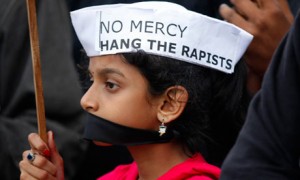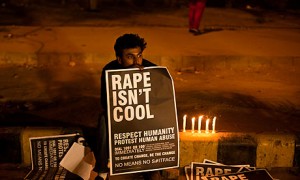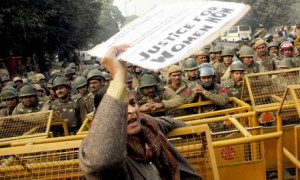indian gang-rape case reveals horrors beyond the incident
There has been rape, murder, grief. There have been protests, riots, violence. There have been calls for hangings, rights, guns. There has been grief, anger, shame. There has been a funeral.
On 16 December in New Delhi, India, a 23-year-old woman was raped by six men on a bus. She was beaten with an iron rod. She died from internal injuries ten days later. The attack has caused outcry in India and internationally. People have marched, calling for the death of the accused and for protection of women. The world is looking at India and India is looking into itself.
The woman, whose name has not been released under a Supreme Court ruling, boarded a bus with her male friend. Six men, (brothers Ram and Mukesh Singh, Pawan Gupta, Vinay Sharma, Aksay Kumar Thakur and an unidentified 17-year-old), beat the boyfriend and, over the course of an hour, took turns raping the woman.
‘From where we boarded the bus, [the attackers] moved around for nearly two and a half hours. We were shouting, trying to make people hear us. But they switched off the lights of the bus.’
– The woman’s friend, reported by The Guardian.
The bus continued on its path and passed numerous police cars. The men threw the couple from the bus and attempted to reverse over the woman – her friend dragged her to safety.
Passers-by ignored the pair for close to an hour, leaving her naked and bleeding on the street. They pleaded for help but none was forthcoming:
‘There were a few people who had gathered round, but nobody helped. Before the police came I screamed for help but the autorickshaws, cars and others passing by did not stop.
‘You have to help people on the road when they need help.’
A police van arrived after 45 minutes; the officers spent time arguing about where to take them. Police spokesman Rajan Bhagat told Reuters the van arrived within four minutes of being called.
‘We kept shouting at the police, ‘Please give us some clothes,’ but they were busy deciding which police station our case should be registered at,’ said her friend.
Bhagat claims that police had the pair at a hospital within 24 minutes
The woman’s condition worsened following organ failure. On 26 December she was moved to a hospital in Singapore. She died on 28 December.
‘Despite all efforts by a team of eight specialists to keep her stable, her condition continued to deteriorate over these two days. She had suffered from severe organ failure following serious injuries to her body and brain.
‘… [T]he trauma to her body was too severe for her to overcome.’
– Kelvin Loh, chief executive of Mount Elizabeth hospital
Arrests began 36 hours after the attack. Gupta and Sharma confessed immediately. Five of the accused were charged with murder on 3 January. The sixth man will be charged separately – he’s under 18 years old and cannot be prosecuted for murder. If convicted, the group face death.
The woman’s family supports this: ‘The whole country is demanding that these monsters be hanged. I am with them,’ said her father. Her brother was no less subtle: ‘The fight has just begun. We want all the accused hanged and we will fight for that, till the end.’
The family have support: protesters have called for the accused’s hanging since the attack. Protests were loud and consistent. Outraged citizens filled the streets and demanded action, change. They were, on occasion, met with violence.
Along with calls for death, many have demanded a re-shaping of the legal system. Many want rape cases to be tried within 90 days to speed up processing (a shortage of judges in India means that cases often take years to reach trial). Others want tougher punishments for rapists (eg chemical castration). Government officials and police officer were criticised early on for slow and underwhelming responses, both historically and in the present. Both groups are now being forced to react and take steps towards protecting women in India.
More than 18,000 suggestions on changing rape laws have been made by the public. A task force has been established to monitor women’s safety in Delhi. The police will be reviewed to ensure they’re doing their job; forty police have been sent on a three-day rape investigation and ‘gender-sensitisation’ training course. Parliamentarians who face sexual assault charges may soon be suspended: Indian political parties have nominated 260 candidates awaiting trail on charges of crime against women, including six at state-level facing rape charges.
However, changes to the law will be for nought if its not accompanied by changes to the culture.
In Delhi alone, a woman is raped every fourteen hours. This amounts to 625 a year. The Wall Street Journal posted data on rape convictions across India in 2011. 15,423 cases were tried; 4,072, or 26.4%, resulted in a conviction. That leaves 11,351 acquittals.
The attack has resulted in Indian media reporting previously ignored examples of sexual violence.
‘[T]hese have included a teenager fleeing repeated abuse by her brother, who was allegedly assaulted on a bus by a conductor, a 15-year-old held for 15 days by three men in a village in Uttar Pradesh and repeatedly assaulted, an 11-year-old allegedly raped by three teenagers in the north-eastern city of Guwahati and two cases of rape in the city of Amritsar.’
– Jason Burke, Indian bus rape: Delhi sees rush for guns, The Guardian.
These reports do not include the other forms of violence against women, such as the hundreds of thousands of foetuses that are aborted each year because they’re not male or honour killings – women killed by family members or loved ones for disgrace the family, usually surrounding marriage and relationships. The Honour Based Violence Awareness Network estimates that 1000 honour-based murders happen in India every year. Many cases aren’t taken seriously by authorities.
Many fear that the attack will result in further constraints on women (especially those in rural and poverty-stricken areas). Mobile phones haven been banned and ‘sexy’ clothing warned against in Matapa, Bihar; elders claim this will restore ‘social order’. Mobile phones have been blamed for the corruption of ‘traditional values’.
A parliamentarian in the state of Rajasthan called for a ban on skirts in an attempt to keep ‘men’s lustful gazes’ away from schoolgirls. (Private schools that allow their students to wear skirts have been blamed for increased sexual harassment in the area.)
Contrasting with moves to depower women, many have taken steps to empower themselves: hundreds of women have applied for gun licences in Delhi since the attack. Since 18 December, police have received 274 requests for gun licences and 1,200 inquires. 500 applications were made in all of 2011.
Violence and the oppression of women is deeply engrained into many parts of India and that is coming into conflict with a growing middle-class that demands, and expects, change. Growth and urbanisation have brought these realities into contact and conflict. While the past few weeks have been tumultuous there is a sense that lasting change will be achieved – but perhaps at the cost of more violence.
The problems, while extreme in example, are not limited to India.
In an opinion piece for The Guardian, Emer O’Toole highlights the contradictions inherent in much Western reporting on India:
‘[T]his BBC article states, as if shocking, the statistic that a woman is raped in Delhi every 14 hours. That equates to 625 a year. Yet in England and Wales, which has a population about 3.5 times that of Delhi, we find a figure for recorded rapes of women that is proportionately four times larger: 9,509. Similarly, the Wall Street Journal decries the fact that in India just over a quarter of alleged rapists are convicted; in the US only 24% of alleged rapes even result in an arrest, never mind a conviction.’
India has a conviction rate higher than not just the US, but also the UK and Sweden. This is not just a moment to look to India with horror at what has occurred and hope for those working for change; it is also a moment to look at ourselves.
By Cory Zanoni
Image Credits : (1) Aijaz Rahil, AP (2) Dar Yasin, AP (3) Anindito Mukherjee, EPA
Please remember to check out our comment guidelines before commenting.





“T]his BBC article states, as if shocking, the statistic that a woman is raped in Delhi every 14 hours. That equates to 625 a year. Yet in England and Wales, which has a population about 3.5 times that of Delhi, we find a figure for recorded rapes of women that is proportionately four times larger: 9,509”
I think that, considering everything we know about cultural perceptions of women in India, it’s probably the case that women in the West are simply far more likely to report incidents of sexual assault than in India. The idea that sexual assault only occurs once every 14 hours in Delhi seems to me to me to be incredibly fanciful.
Despite the fact that Western countries have a long way to go in terms of confronting rape culture, many of the problems raised the Indian example *aren’t* problems in the West. For example:
“..honour killings – women killed by family members or loved ones for disgrace the family,”
“..Indian political parties have nominated 260 candidates awaiting trail on charges of crime against women..”
“Passers-by ignored the pair for close to an hour, leaving her naked and bleeding on the street. They pleaded for help but none was forthcoming.”
The Indian gang-rape case is an opportunity to look within ourselves, but we should caution ourselves from creating a false equivalence that obscures the differences between the Western and Indian mainstream perceptions of women.
Hi Chris, thanks for the comment.
I don’t think there’s much danger of creating a false equivalence between mainstream perceptions of Western and Indian women – for the reasons you highlighted.
If anything the occasional commentator has gone the other way, pointing at the past few weeks in India as if to say “What are women in the West complaining about really?” (A line-of-thought I would’ve liked to draw out further in my article but time got away from me.)
A link to the BBC article claiming ‘rape every 14 hours’: http://bbc.in/TWKOnx
The article cites “official sources” but doesn’t offer anymore information, making it nigh on impossible to verify without contemptuous levels of Googling. I agree it does seem fanciful but without any other numbers it’s just conjecture. Hopefully more accurate statistics emerge soon.
I agree that the higher incidence of rape in the UK/Wales is likely due to a greater percentage of total rapes are reported. And if people are more likely to come forward, that’s a great thing. What’s troubling is that despite (an arguably) higher percentage of reporting there’s still a lower rate of conviction.
Undoubtedly there’s a difference between the everyday experiences of Indian and Western women; the danger lies in letting those surface differences (and the safety they imply for the West) obscure issues the West still has.
(That being said I think talking about ‘the West’ in broad strokes is limiting to any kind of constructive conversation [despite the fact I do it so often]. Does anyone have any statistics on conviction rates in Australia? The best I could find were both vague and out-dated.)
I agree that ‘the West’ is a broad term, but it’s useful for the purposes of distinguishing post-industrial developed capitalist societies from ‘developing’, part-capitalist part-agrarian and traditionalist societies.
“What’s troubling is that despite (an arguably) higher percentage of reporting there’s still a lower rate of conviction.” – That’s a very fair point – the UK conviction stats I looked at were about 6-8%, and this is something that needs to change. My problem with the Emer O’Toole article (and the recent Libby Brooks article on the same subject) on The Guardian is that I don’t think they adequately explain the reasons why the conviction rate is so low.
I would love to see an article focusing on certain aspects of the low conviction rate rather than just the meta-narrative of “Western attitudes”. For example; whether the Common Law system is centered upon assumption of innocence and presentation of evidence, which is simply not possible in cases which hinge on issues of consent rather than the definitive proof of wiretaps, murder weapons, and bodies. Whether the problem is specific institutional failings of the police and the inadequacy of the support networks designed to assist rape victims (as is implied in a 2007 UK Govt report I just came across)? As someone who identifies on the Left, I would love to see a left-leaning commentator try and explain the low conviction rate in more incisive terms rather than just pinning it on culture (the unfalsifiable explanation), because i doubt a less than 10% conviction rate directly implies that more than 90% of Westerners think women deserve it.
Enjoyed the article btw!
Pingback: Feminist News Round-up 13.01.13 | News | Lip Magazine
Pingback: Serena Williams on Steubenville Rape Victim: 'She's 16. Why was she drunk?' | Opinion | Lip Magazine